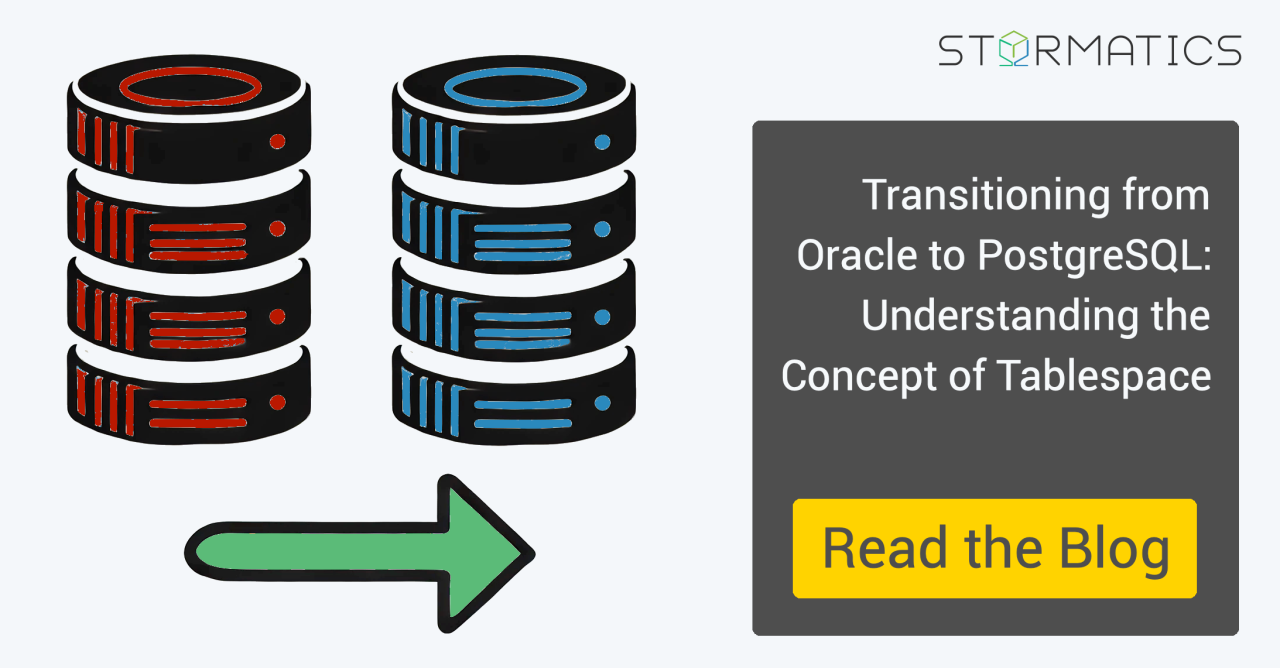
Transitioning from Oracle to PostgreSQL: Tablespaces
Umair Shahid
PostgreSQL Thought Leader | Keeping Critical Databases Fast, Reliable, and Resilient
Tablespaces play an important role in database management systems, as they determine where and how database objects like tables and indexes are stored. Both Oracle and PostgreSQL have the concept of tablespaces, but they implement them differently based on the overall architecture of each database.
Oracle’s tablespaces are an integral part of the database that provide various functionalities, including separating data types, managing storage, and optimizing performance. PostgreSQL, on the other hand, takes a more simplified approach, using tablespaces primarily to control where physical files are stored.
This blog aims to provide a comprehensive comparison between Oracle and PostgreSQL tablespaces, covering their architecture, creation, and practical use cases, with the goal of helping DBAs better understand their capabilities and limitations
1. Overview of Tablespaces in Oracle and PostgreSQL
Oracle’s Approach to Tablespaces
In Oracle, tablespaces are logical storage units that consist of one or more data files. These data files store the actual data, such as tables, indexes, and materialized views. Oracle uses several different types of tablespaces to serve specific purposes:
Oracle’s approach allows DBAs to manage storage performance, optimize I/O, and facilitate database maintenance.
PostgreSQL’s Approach to Tablespaces
PostgreSQL tablespaces are much simpler compared to Oracle’s, mainly serving as pointers to directories in the file system where the database stores its data. The default location for storage is the data directory (pg_default), but custom tablespaces can be created to manage storage across different physical disks.
Unlike Oracle, PostgreSQL does not include specialized tablespaces for temporary or undo data; instead, these functions are handled differently within the database, relying on MVCC for read consistency and filesystem directories for storage.
2. Creation and Management of Tablespaces
Oracle Tablespace Management
Creating and managing tablespaces in Oracle involves several advanced features:
CREATE TABLESPACE user_data?
DATAFILE '/u01/app/oracle/oradata/orcl/user_data01.dbf' SIZE 100M?
AUTOEXTEND ON NEXT 10M MAXSIZE 1G;Copy to Clipboard
This command creates a user_data tablespace with a data file that grows as needed.
PostgreSQL Tablespace Management
In PostgreSQL, tablespaces are created using the CREATE TABLESPACE command and are associated with a specific directory. For example:
CREATE TABLESPACE fast_storage LOCATION '/mnt/ssd/pg_fast_storage';Copy to Clipboard
This command creates a fast_storage tablespace that points to the /mnt/ssd/pg_fast_storage directory.
Directory-Based Management: Unlike Oracle’s data file system, PostgreSQL tablespaces rely directly on the file system. There is no auto-resizing or extent manag
3. Architectural Differences
Data File Handling
领英推荐
Purpose and Complexity
4. Practical Usage and Application
Oracle Use Cases
Oracle tablespaces are used for:
PostgreSQL Use Cases
PostgreSQL tablespaces are often used to:
5. Backup, Recovery, and Maintenance
Backup Strategies
Maintenance Tasks
6. High Availability and Performance Considerations
Performance Optimization
7. Migration Considerations
Migrating from Oracle to PostgreSQL requires careful mapping of tablespace functionalities:
Conclusion
Oracle and PostgreSQL offer tablespaces as a way to manage physical data storage, but their implementation differs significantly. Oracle tablespaces are complex, feature-rich, and capable of handling specialized storage needs for system, temporary, and undo data. PostgreSQL takes a more simplified approach, allowing DBAs to control storage locations through file system directories.
Understanding these differences is crucial for DBAs, particularly when planning migrations or optimizing database performance across different systems.
Further Reading